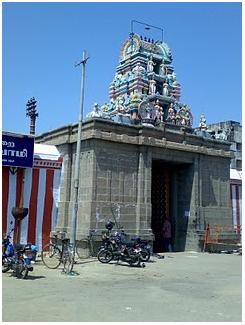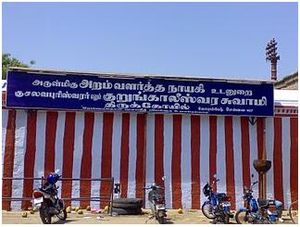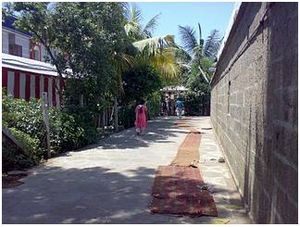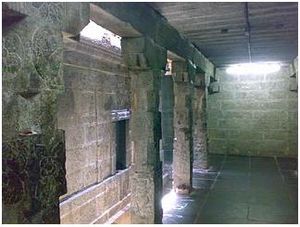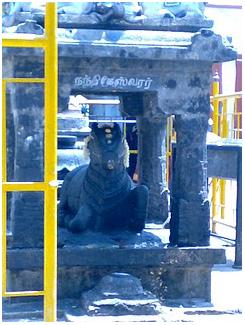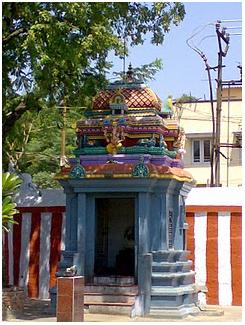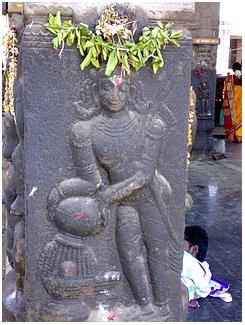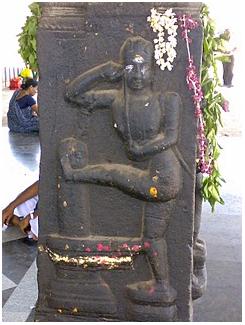Koyambedu Sri Kurungaaleeswarar
This ancient temple was constructed for Lord Shiva and is located in Koyambedu, a small town located northwest of Chennai. The main deity is Sri Kurungaaleeswarar (also called Sri Kusalavapureeswarar) and Goddess is Sri Dharmasamvardhani (also called Aram Valartha Naayagi). It is said that Koyambedu, in ancient times, was also known by the names Kosai Nagar, Koyattipuram and Prayachithapuram.
The inscriptions in the temple date back to Kulothunga Chozha III and the Vijayanagara kings, who made noteworthy contributions to the temple. Kulothunga Chozha is said to have ruled the region in the 12th century A.D., and hence it is believed that at least part of the temple was constructed during his reign. The inscriptions also reveal the political bifurcation of this place as Kulothunga Chozha Valanadu, part of Puliyur Kottam, that belonged to Jayankonda Chozha Mandalam.
The legend of this temple traces back to Ramayana period, when Sita Devi was sent to the forest by Sri Rama. Sita was under the care of Sage Sri Valmiki during that period and it was then that she birth to her two sons Lava and Kusa. It is said that Lava and Kusa, the sons of Sri Rama, stayed with Sage Valmiki in his ashram along with their mother, Sita. Besides Koyambedu, there are few other places too near Chennai, like Thiruvaanmiyur and Siruvapuri, where Sage Valmiki had his ashrams when Lava and Kusa stayed with him.
When Sri Rama sent the horse Aswamedha on a tour across the country, Lava and Kusa took the horse in their custody. Without knowing that it was his sons who captured the horse, Sri Rama sent his brother Lakshmana to fight a battle with them. As Lava and Kusa fought against their own uncle, they acquired a Dhosham called Gothra Dhosham. To be relieved of it, they erected a temple and worshipped Lord Shiva in Koyambedu.
The presiding deity, Sri Kurungaaleeswarar, is quite small in size, as Lava and Kusa were still children at the time they installed it. In spite of this, the temple has stood strong across centuries and still has not lost its original grandeur. It has many beautiful stone-pillared praakaarams around the sanctum. Another beautiful stone-pillared Mandapam is found in front of the temple, in which Sri Sarabeswarar is seen on one of the pillars facing west. Special poojas are performed for Sri Sarabeswarar on all Sundays during Raahu Kaalam. At the outer praakaaram, the Sri Vinayagar shrine is located at the southwest corner of the temple.
Sri Visaalaakshi Samedha Sri Kaasi Viswanathar shrine and Sri Valli Devasena Samedha Sri Subramanyar shrine are located adjacent to each other behind the sanctum. Sri Nandhigeswarar is seen on the outer praakaaram, facing the presiding deity. The temple also maintains a beautiful garden (Nandhavanam) along the outer praakaaram. Ambaal Sri Dharmasamvardhani is beautiful and is seen in a standing posture. The Sthala Viruksham for this temple is known as ‘Palaa Maram’ (Jack tree), and is located on the outer praakaaram.
The theertham for this temple is called Lava Kusa Theertham, which is believed to have been created by Lava and Kusa. There are many beautiful sculptures all around the temple and on the pillars. Some of them show Sri Rama performing pooja to Lord Shiva, while others show Lord Shiva punishing Yama to save Markandeyan and Kannappa Naayanar. There is another temple adjacent to the Koyambedu temple, which is dedicated to Maha Vishnu. It is called Sri Vaikunda Vaasa Perumal temple, which also was constructed by Lava and Kusa.

